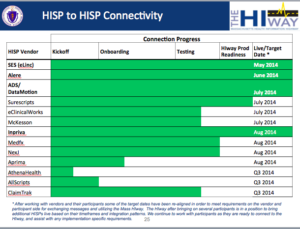 Stage 2 Readiness For Use in the Next Few Weeks
Stage 2 Readiness For Use in the Next Few Weeks
By John Halamka, MD
Twitter: @jhalamka
Hospitals across the country have until September 30 to complete their 2014 reporting period for Meaningful Use Stage 2.
Recently Ashish Jha and Julia Adler-Milstein published important articles in Health Affairs about the current state of EHRs and Health Information Exchange. What can we learn about the status of Meaningful Use Stage 2 across the country?
The trajectory is very positive but the position is less than perfect. Hospitals are struggling with patient view/download/transmit and provider/provider transition of care summaries. Eligible professionals, often with limited resources, are implementing Stage 2 certified software less rapidly than hoped.
As Beth Israel Deaconess completes it’s 2014 reporting period, we’re very close, approaching the finish line.
We’ve certified all our self built systems for both inpatient and ambulatory 2014 criteria.
We’ve outsourced the Meaningful Use quality measure computations to the Massachusetts eHealth Collaborative.
Last week we completed a milestone, using our self built iPhone/iPad-based electronic medication record (EMAR) to administer the one millionth medication dose since go live. Our 10th inpatient unit is now live with 100% of doses bar coded. The Emergency Department goes live in early September.
The patient View/Download/Transmit function is undergoing broad rollout and we’re on target to surpass the 5% Meaningful Use transaction volume requirement. Although many hospitals have been challenged to get patients signed up for a personal health record, resorting to registering them during the discharge process, BIDMC has been using a patient/doctor shared medical record since 1999, so we already have the patients enrolled.
Transitions of care, with a 10% transaction volume requirement, is our final hurdle. Although BIDMC has been sending clinical transactions for years, the number of trading partners capable of receiving Meaningful Use Stage 2 is limited, especially smaller clinician offices.
Below is a timeline for integration of various vendors and health information service providers (HISPs) into the Massachusetts HIE.
 Luckily, one of our major referral partners, Atrius Healthcare, represents over 10% of our discharges. Their Epic system is already connected to the HIE and is in the final stages of testing. Later this month, we should be able to pass the 10% threshold. However, it’s not entirely under our control since the transitions of care requirement depends upon an ecosystem of connectedness that is still evolving. On some days it feels that we have the only fax machine in town and thus it’s hard to fax.
Luckily, one of our major referral partners, Atrius Healthcare, represents over 10% of our discharges. Their Epic system is already connected to the HIE and is in the final stages of testing. Later this month, we should be able to pass the 10% threshold. However, it’s not entirely under our control since the transitions of care requirement depends upon an ecosystem of connectedness that is still evolving. On some days it feels that we have the only fax machine in town and thus it’s hard to fax.
Over the next few weeks, we’ll complete an external review of our readiness as well as an updated security audit. And just in case, we’re all awaiting word on the NPRM offering possible flexibility for Stage 2 attestation requirements for 2014.
John D. Halamka, MD, MS, is Chief Information Officer of Beth Israel Deaconess Medical Center, Chairman of the New England Healthcare Exchange Network (NEHEN), Co-Chair of the HIT Standards Committee, a full Professor at Harvard Medical School, and a practicing Emergency Physician. This article was originally published in his blog Life as a Healthcare CIO and is reprinted here with permission.
